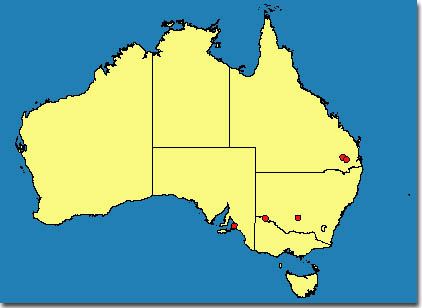 |
 |
||
|
|
|||
| Diagnosis | Encarsia pergandiella Howard |
|||||||||||||
| Species group | ||||||||||||||
| Distribution | ||||||||||||||
| Host | ||||||||||||||
| Comments | ||||||||||||||
| Illustrations | ||||||||||||||
| DNA | ||||||||||||||
Encarsia pergandiella Howard, 1907: 78. Holotype female, USA, Washington, D.C., 25.ix.1900 (T. Pergande), ex 'Aleyrodes' [probably Trialeurodes sp.] on Xanthium strumarium (USNM). Encarsia versicolor Girault, 1908: 53. Synonymy by Gahan (in Peck 1951): 438. Aleurodiphilus pergandiellus (Howard): DeBach & Rose, 1981: 666. Encarsia bemisiae De Santis, 1981: 37. Preoccupied by bemisiae Ishii 1938. Holotype female, Brazil, Sao Paolo, Campinas, B. tabaci (Lourençao), (UNLP). Synonymy by Polaszek et al., 1992: 387. Encarsia tabacivora Viggiani, 1985a: 82. Replacement name for bemisiae De Santis. Synonymy by Polaszek et al., 1992: 387. |
||||||||||||||
Diagnosis |
FemaleColourHead and mesosoma predominantly yellow with pronotum, mesonotum and axillae largely brown. Antenna yellow, apex slightly darkened. Gaster largely brown. Fore wing with infuscate band behind marginal vein and with bare area near leading edge. MorphologyAntenna slender with 2-segmented clava. Pedicel longer than F1 (1.27-1.36). F1 subequal to or slightly shorter than F2 (0.90-1.00) and slightly shorter than F3 (0.77-0.85). Scutellar sensilla widely separated (approximately 6 x the width of a sensillum). Distance between anterior pair of scutellar setae subequal to distance between posterior pair. Fore wing 3.4-3.6 x as long as wide. Marginal fringe of fore wing 0.68-0.75 x as long as wing width. Tarsus of middle leg 5-segmented. Apical spur of middle tibia shorter than half the length of the relatively long and slender basal tarsal segment (0.37-0.41). Ovipositor almost as long as the length of the middle tibia (0.84-0.91). Third valvula 0.54-0.70 x as long as second valvifer. MaleHead and body predominantly brown, mid lobe of mesoscutum, scutellum and legs lighter. |
|||||||||||||
Species
|
Placed in E. pergandiella-group by Viggiani & Mazzone (1979) and Viggiani (1993), and in E. parvella-group by Hayat (1989, 1998) and Polaszek et al. (1992), ), which these authors consider encompasses the E. pergandiella-group. |
|||||||||||||
Distribution
|
 Click here for material examined window. |
|||||||||||||
Host |
B. tabaci (Gennadius), T. vaporariorum (Westwood). The following additional hosts have been recorded (Polaszek et al., 1992; Schauff et al., 1996): Aleyrodes sp., Aleurodicus dispersus Russell, Aleuroglandulus malangae Russell, Aleuroplatus coronata (Back), A. elemerae Mound & Halsey, Aleurothrixus floccosus (Maskell), Aleurotrachelus trachoides (Quaintance), Dialeurodes citri (Ashmead), D. kirkaldyi (Kotinsky), Trialeurodes abutiloneus (Haldeman), T. floridensis (Quaintance), T. variabilis (Quaintance). |
|||||||||||||
Comments |
This species has, similar to E. mineoi, 5-segmented tarsi of the middle legs and a bare area near the leading edge of the fore wing, but unlike in E. mineoi, the gaster is completely dark. |
|||||||||||||
Illustrations |
|
|||||||||||||
DNA
|
28S-D2 rDNA: GenBank Accession Code: AF254223-AF254225. |
|||||||||||||
| © Copyright 2001, CSIRO Australia |
| [webmaster - February 2001] |
| Use of this web site and information available from it is subject to our |
| Legal Notice and Disclaimer |